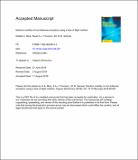Files in this item
Electron mobility of non-fullerene acceptors using a time of flight method
Item metadata
| dc.contributor.author | Mica, Natalie A. | |
| dc.contributor.author | Thomson, Stuart A. J. | |
| dc.contributor.author | Samuel, Ifor D. W. | |
| dc.date.accessioned | 2019-08-11T23:42:27Z | |
| dc.date.available | 2019-08-11T23:42:27Z | |
| dc.date.issued | 2018-12-01 | |
| dc.identifier | 255272447 | |
| dc.identifier | b916c3ba-2845-4406-b7c5-65c553169896 | |
| dc.identifier | 85057198863 | |
| dc.identifier | 000449270700056 | |
| dc.identifier.citation | Mica , N A , Thomson , S A J & Samuel , I D W 2018 , ' Electron mobility of non-fullerene acceptors using a time of flight method ' , Organic Electronics , vol. In press . https://doi.org/10.1016/j.orgel.2018.08.027 | en |
| dc.identifier.issn | 1566-1199 | |
| dc.identifier.other | RIS: urn:C4274AF5720C9F2EFF292ACBBD8874E6 | |
| dc.identifier.uri | https://hdl.handle.net/10023/18290 | |
| dc.description | Natalie A. Mica and Stuart A. J. Thompson acknowledge student funding from EPSRC. [grant nos. EP/L015110/1 and EP/G03673X/1] Ifor D. W. Samuel acknowledges support from a Royal Society Wolfson Research Merit award. | en |
| dc.description.abstract | Organic solar cells are a promising renewable energy technology, offering the advantages of mechanical flexibility and solution processability. The charge carrier mobility is an important parameter as it influences the competition between charge extraction and recombination and therefore the cell efficiency. We report the electron mobility of two high performance non-fullerene acceptors ITIC and IDTBR in neat films and blended with their common donors. In a pure film ITIC has a zero-field electron mobility of 7.4 × 10−4 cm2/Vs, which dropped to 1.0 × 10−4 cm2/Vs when put into a blend with PTB7-Th or P3HT. The IDTBR:P3HT blend was found to have a slightly lower electron mobility of 5.6 × 10−5 cm2/Vs. The measured electron mobility is the same order of magnitude as the hole mobility in these blends, leading to balanced transport and efficient photovoltaic cells. | |
| dc.format.extent | 1277490 | |
| dc.language.iso | eng | |
| dc.relation.ispartof | Organic Electronics | en |
| dc.subject | Non-fullerene acceptor | en |
| dc.subject | Time of flight | en |
| dc.subject | Mobility | en |
| dc.subject | QC Physics | en |
| dc.subject | DAS | en |
| dc.subject | SDG 7 - Affordable and Clean Energy | en |
| dc.subject.lcc | QC | en |
| dc.title | Electron mobility of non-fullerene acceptors using a time of flight method | en |
| dc.type | Journal article | en |
| dc.contributor.sponsor | EPSRC | en |
| dc.contributor.sponsor | EPSRC | en |
| dc.contributor.institution | University of St Andrews. School of Physics and Astronomy | en |
| dc.contributor.institution | University of St Andrews. Condensed Matter Physics | en |
| dc.identifier.doi | 10.1016/j.orgel.2018.08.027 | |
| dc.description.status | Peer reviewed | en |
| dc.date.embargoedUntil | 2019-08-12 | |
| dc.identifier.grantnumber | EP/C542398/1 | en |
| dc.identifier.grantnumber | EP/L015110/1 | en |
This item appears in the following Collection(s)
Items in the St Andrews Research Repository are protected by copyright, with all rights reserved, unless otherwise indicated.

